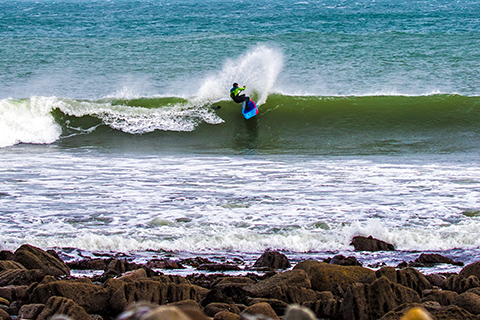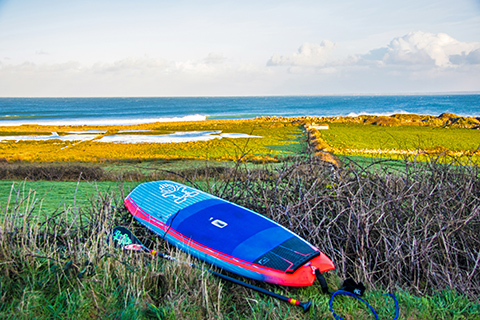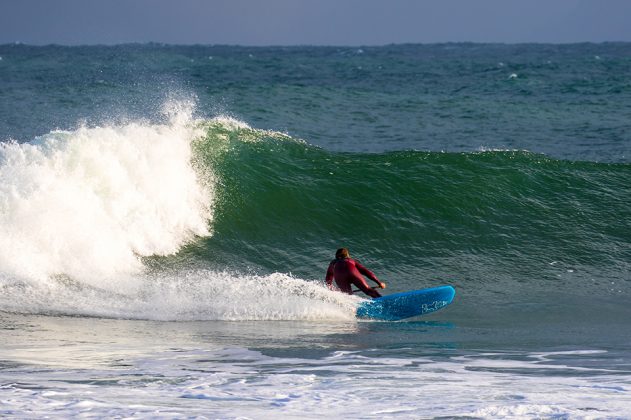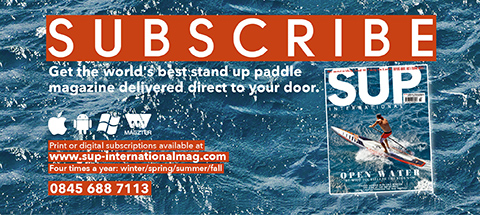BOARD TECH –
SHORT & SWEET
With – Finn Mullen
Photo – Mikee Hamilton
For over a year now, the ‘compact’ SUP shape has been in the market with nearly all brands offering a variation of the shaping concept that was pioneered in surfing, but has now established itself in SUP, kitesurfing and windsurfing. Finn Mullen, an initial sceptic of the shape, is now a converted fan and here explores the history, techniques and tips for this new generation of SUP shapes that have allowed many riders their first taste of a ‘shorter’ SUP wave board.
HISTORY
“I just enjoy the process of looking for something new. And I think everyone should do that. Whether it’s shaping their own boards or riding something totally off the wall and different from what they ride now. Surf switch foot for a while. Whatever.” – Kelly Slater.
In times past, if you walked down the beach with what looked like a door under your arm, you’d get more ridicule than Donald Trump in a Mexican restaurant. These days everyone from weekend warrior to Kelly Slater (who famously on YouTube has actually surfed a door) has embraced the compact board concept. The idea began in surfing as the brainchild of Australian Daniel “Tomo” Thomson, who was inspired by an American shaper, the late Bob Simmons. In 1946 Bob acquired a copy of a lengthy MIT study on planing hulls and began applying its complex equations and theories to surfboards. Conventional board shapes, with a pulled in nose and tail, both then and now use displacement theory in their design, moving in the water efficiently like a ship; the planing hull however is designed to sit on top of the water – Tomo explains further, “The wide tail block and straight outline maximize lift and reduce drag, and you turn using the rail.”
Now commonly referred to as the MPH shape (Modern Planing Hull), when I first saw the concept in SUP, I wasn’t sold but the appeal of being able to squeeze volume into reduced length I was sure was worthy of at least investigation. My first foray into the waves on a tiny surf day convinced me there was merit, with the short length fitting into the small pockets. My real watershed moment however came on a much bigger day after my normal board fell victim to a broken leash and I was forced to use my ‘compact’ on fast, well over head high waves. Far from being a small wave tool, the speed and ‘on rail’ turning characteristics lent the ‘planing hull’ design to big open faces, making it round fast sections and the reduced length easier to squeeze into hollow curls. After a year of riding these designs, here are some tips I’ve found help get the most from these exciting new shapes.
“ In times past if you walked down the beach with what looked like a door under your arm, you’d get more ridicule than Donald Trump in a Mexican restaurant ”
PADDLING
Reduced length means less glide between strokes but the parallel outline generates speed quickly, so acceleration onto a swell line can feel better. Paddle length around head high works best, the short length and wide nose make a longer paddle enter the water at an angle. A short paddle will help you keep a vertical and efficient stroke. Concentrate on your core, thinking about squeezing paddle power from your belly button to help balance. The sweet spot on ‘compact’ SUPs is much more concentrated and less tolerant of bad foot placement so you need to think about keeping the core engaged to stay anchored in that spot and avoid movement that will sink the tail or nose. To reduce yaw, keep your strokes short not long and certainly not past your feet and weight the same rail of the board that you are paddling on. Place your catch as far forward as you can, powering through the first foot of paddle movement. A ‘surf stance’ works best for these boards rather than a parallel feet ‘sup stance’ when paddling in and think about weighting your back foot to keep control and help with later drops. An analogy is to think of a ‘pedal’ between the rear fins of your board and keep your foot on the pedal like an accelerator, more pressure = more take off speed and weight to keep the nose clear. The hull shape by its nature sits on top of the water and can sometimes feel like the nose will dig in but have faith in the planning concept that can sometimes, despite the nose submerging, lift free once the board quickly picks up speed and accelerates you out of trouble. Often I will find my back foot already wedged against the tail pad when paddling in as the increased tail volume allows you to have proportionally increased back foot pressure compared to a normal board.

SURFING
On rail surfing is still the pinnacle of good performance and the amount of speed the planning hulls generate actually encourage this despite their wide tails and thick rails. The key is thinking about setting the turns from the centre rail section rather than the tail rail area of a normal board. The wider tails need more rear foot movement off the top and bottom, don’t be afraid to move your back foot to the inside rail of your top and bottom turn, the increased tail volume allows more foot movement than a normal board so you have time to move and weight your rear foot accordingly in preparation for the move. Think of the front foot as the centre of your turning arc in a more neutral mid position and the rear foot as weighting and position variable, adjusting as required.
Paddle transitions are rewarding to train on these boards, as they are so reactionary yet so stable due to the rectangular planform. Smaller surf days and whitewater can be exploited to practice moving your paddle from side to side in turns as the board’s tail and nose volume is tolerant of mistakes, yet the manoeuvrability of a smaller length board from such little effort makes it easy to understand how the mechanics of good paddle placement and transitions can be used to effect better turns. For this very reason alone these ‘compact’ type boards are worth having in your quiver!
“ The rectangular shape translates to a very ‘scaleable’ design, so the stability and speed these shapes offer are easily transposed into bigger boards and means they are not just ‘experts only’. ”
SETUP
The wide tails of the ‘compact’ shapes makes fin setup even more critical. In the typical quad setup of larger fins forward, I prefer to vary the size of the rear fins according to wave size. At 95 kgs, I use 4.5 inch fins up front with 4 inch at the back for small days and a looser feel, scaling up to 4.25 for more grunt on medium days to 4.5 inch back and front on bigger days for grip and hold and when the turning arc is more drawn out. All that said, world champion Sean Poynter has experimented with running bigger fins at the back than the front on his ‘compact’ SUP and whilst I preferred the drive of a conventional setup it shows how much fin choice affects these board shapes with many people often using a 5 fin configuration of an additional small ‘knubster’ or ‘trailer’ fin for even more hold of the wide tail.
Finally if using rail tape on these boards be aware to start from the very top corner of the nose as the reduced length and extra nose width means you are starting the catch well forward of the nose and the ‘chips’ happen further up the board than a normal shape.

EVOLUTION
The main thing I have learnt after a year on these compact sup shapes is to keep my mind open to the range of new shapes and ideas that are evolving from the surfing world. The rectangular shape translates to a very ‘scalable’ design, so the stability and speed these shapes offer are easily transposed into bigger boards and means they are not just ‘experts only’, where so much performance development has been traditionally focussed on. Most of all the new shapes encourage you to think of new lines, motivate you to try new techniques, prevent stagnation and have a lot of fun along the way. Twenty years from now who knows what the next shapes we will be riding will look like, but at least if you try one of these ‘compact’ shapes you can say, just like Kelly Slater, you (sort of) surfed a door! SUP


